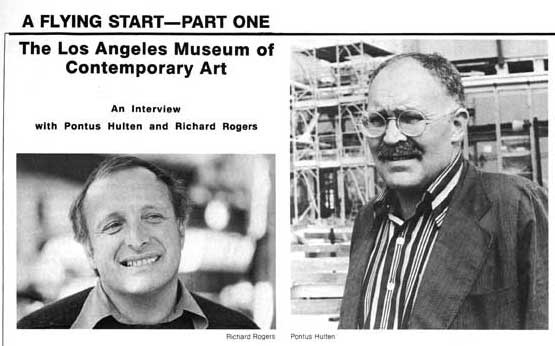A Flying Start – Richard Rogers and Pontus Hulten discuss Beaubourg and MOCA

In this extended interview from 1981, Pontus Hulten, the founding director of the Centre Pompidou in Paris, and Richard Rogers, one of the architects of the Pompidou’s building, discuss what made the Beaubourg a success, and how that success might translate to Los Angeles. The context being that Hulten had just been invited to oversee the creation of a new Museum of Contemporary Art in Los Angeles.
In Paris, Pontus Hulten had created three stupendously successful mega-shows, Paris/New York, Paris/Berlin, and Paris/Moscow, huge, multi-disciplinary exhibits that had attracted record-breaking crowds ranging from half a million to a million visitors to each. Here we learn that MOCA planners anticipated that Pontus Hulten’s ambitious, cross-cultural programming, mixing shows about automobile design and Hollywood style along with retrospectives of Barnett Newman and emerging talent shows, would attract bigger crowds than Dodgers games.
We also learn that, building on his experience in Paris, Pontus Hulten hoped to be working in a flexible space that would allow artists and his curatorial team to take advantage of the light that had inspired so many Los Angeles artists, and that it would open the spaces of the museum to the city in some dynamic way. However, Arata Isozaki had already been retained to design the building, and its placement within the corporate office development on Bunker Hill was established.
It is clear that Richard Rogers had his doubts about all this since, in his view, that part of the success of Beaubourg not attributable to his building had to do with massive national support, a location in a run-down part of town beginning to become hip, and easy accessibility to public transport. Plus, the building housed not only the art galleries and museum but a library, an experimental music facility, film theatres, a restaurant, and a very large public plaza that was open to all at all times.
This interview was published the Los Angeles–based magazine images&issues in spring and summer 1981.